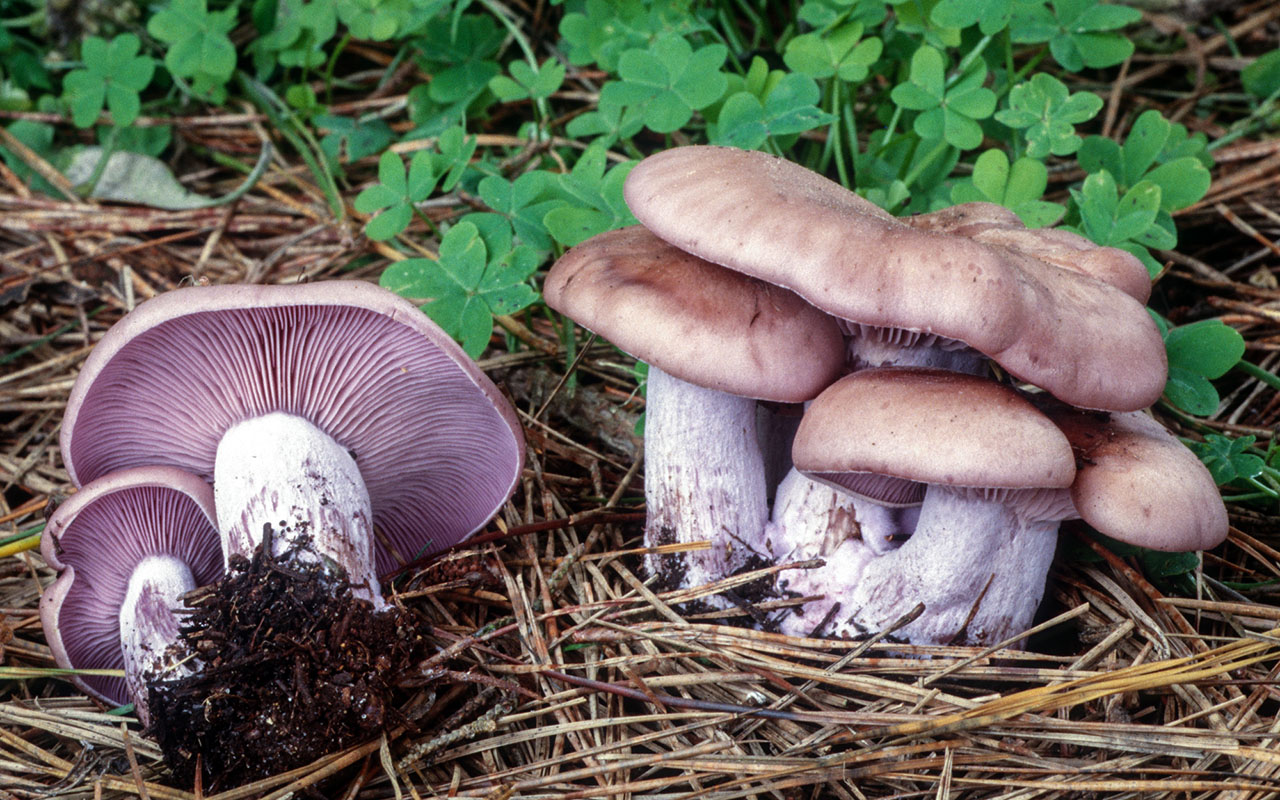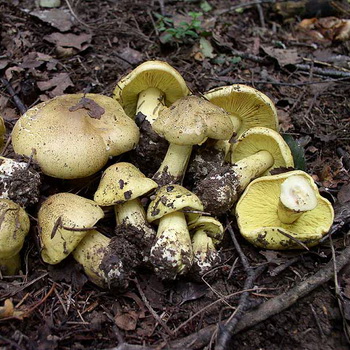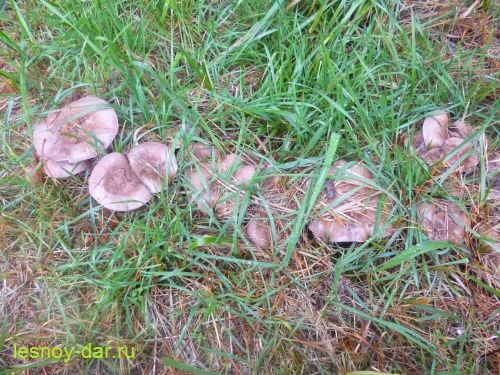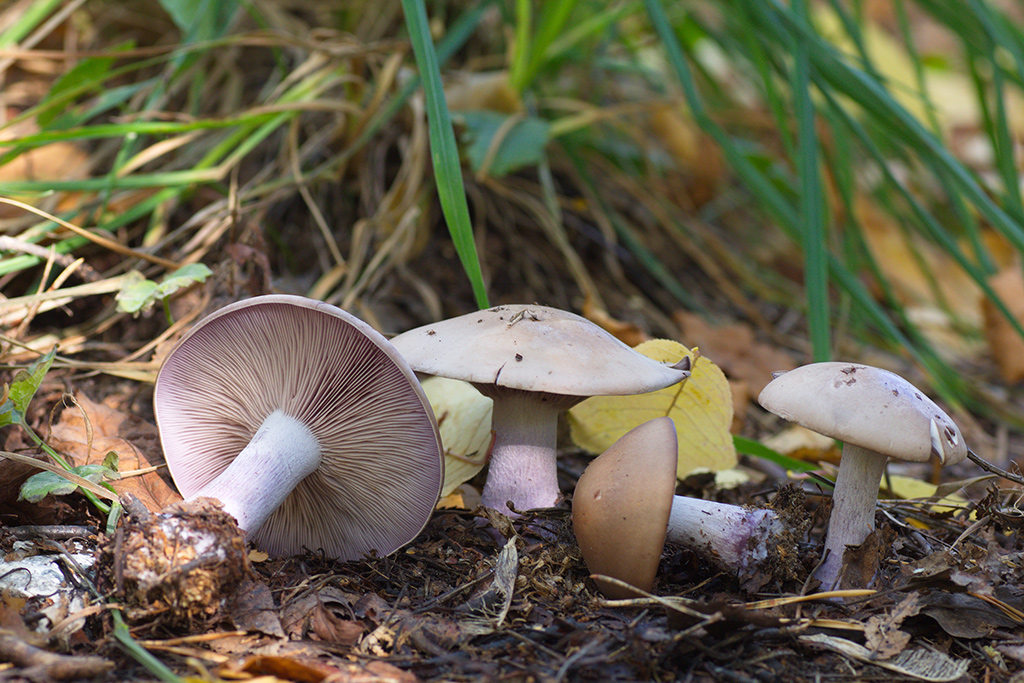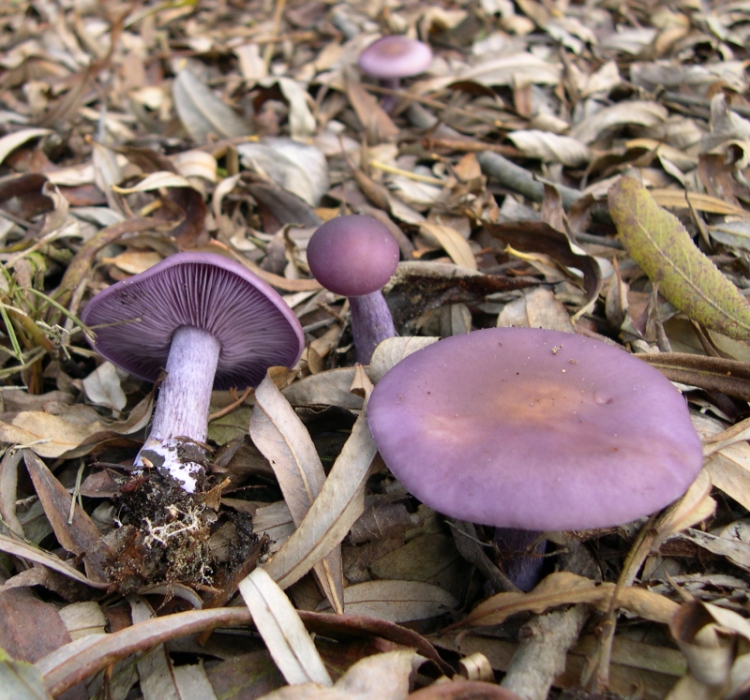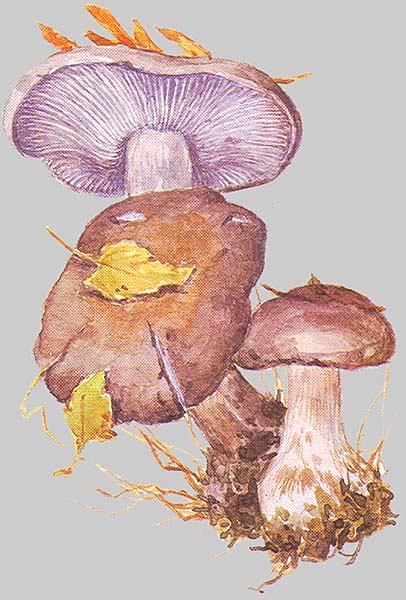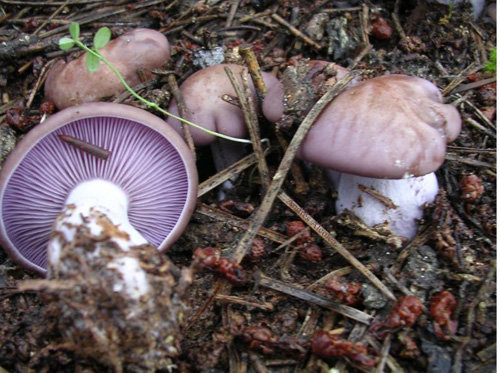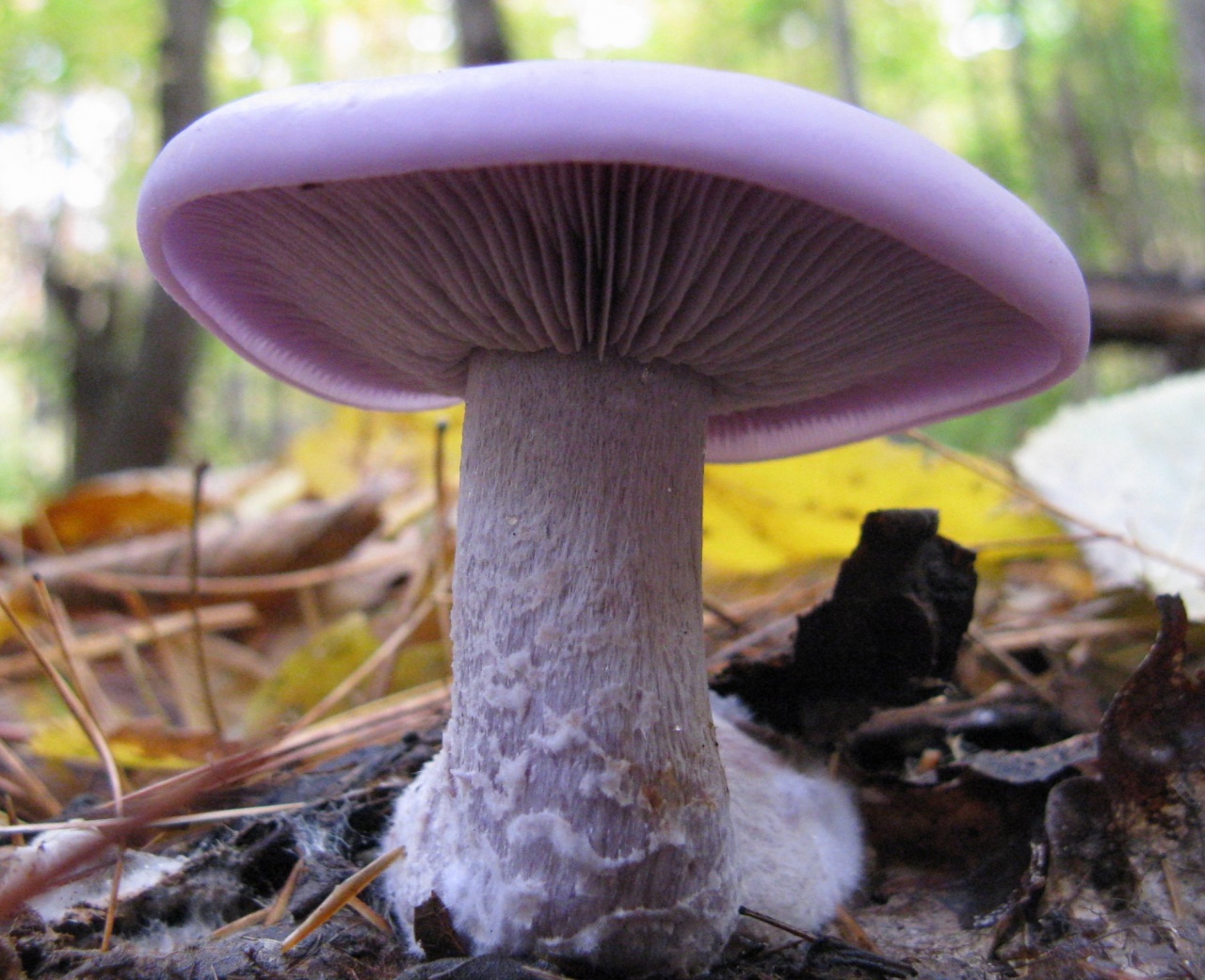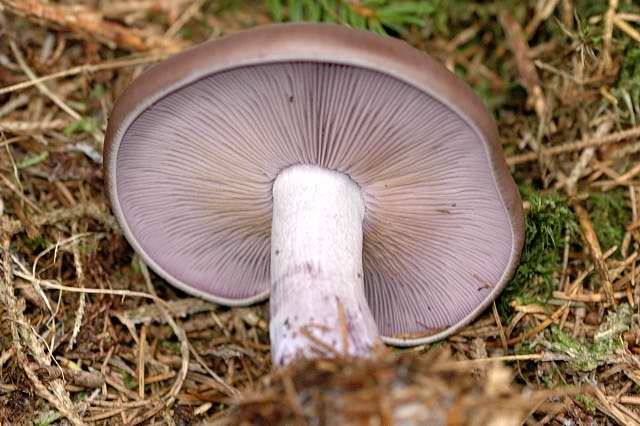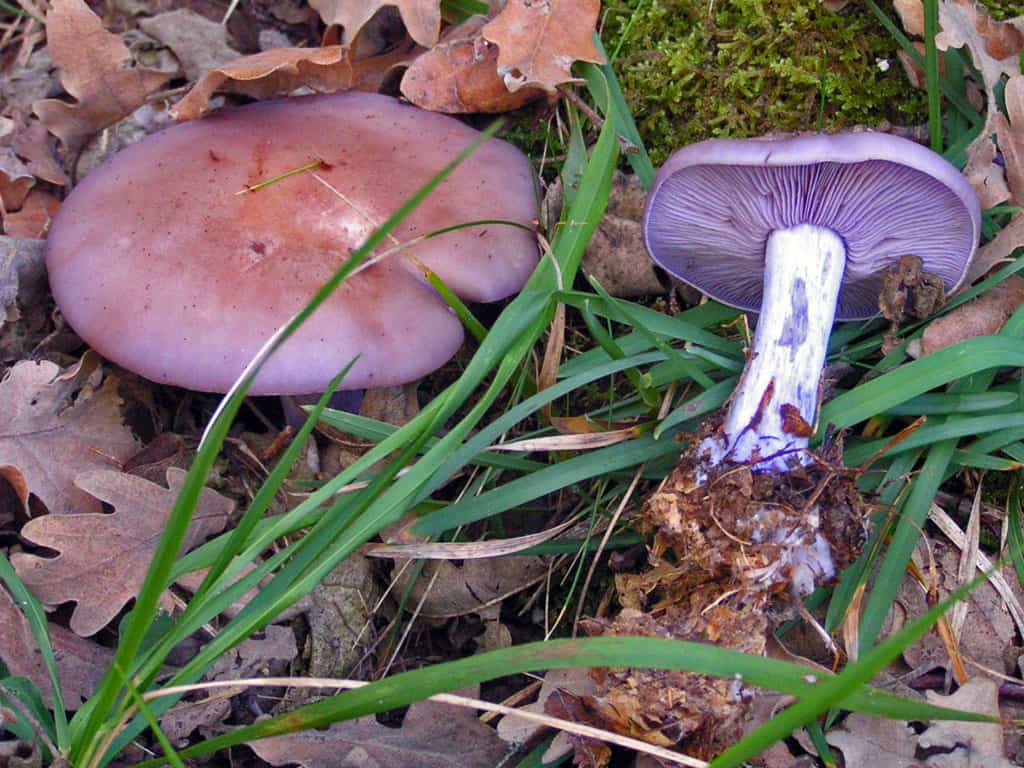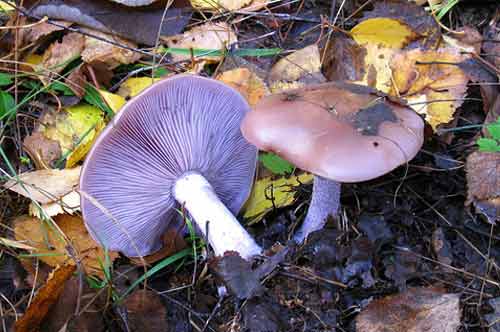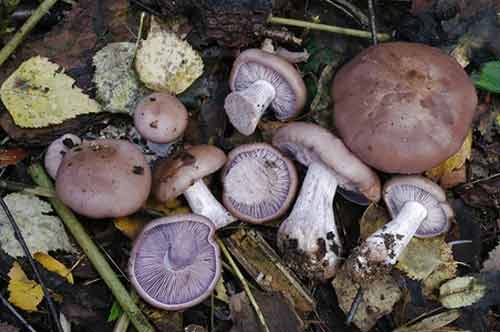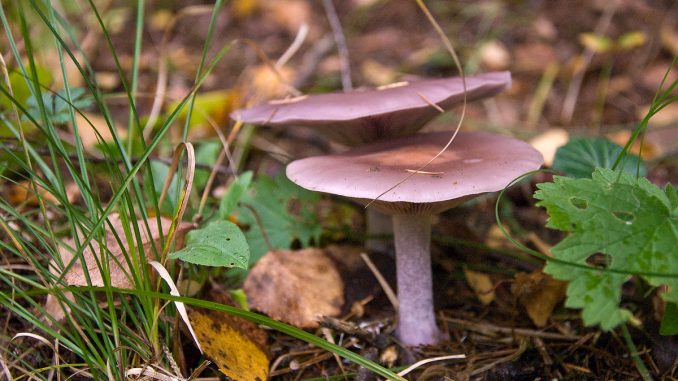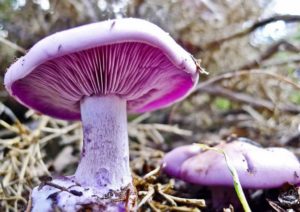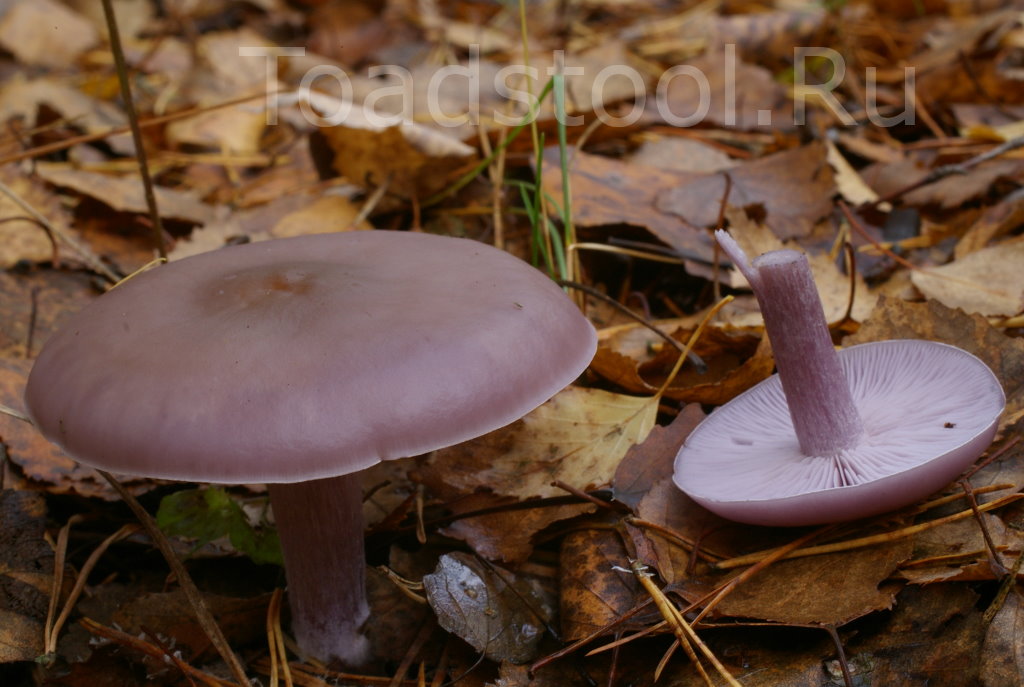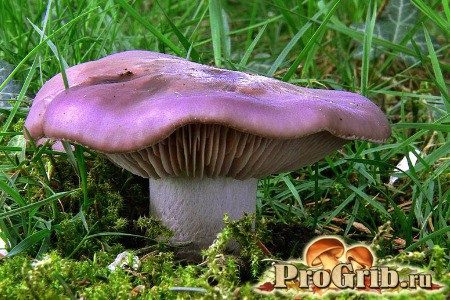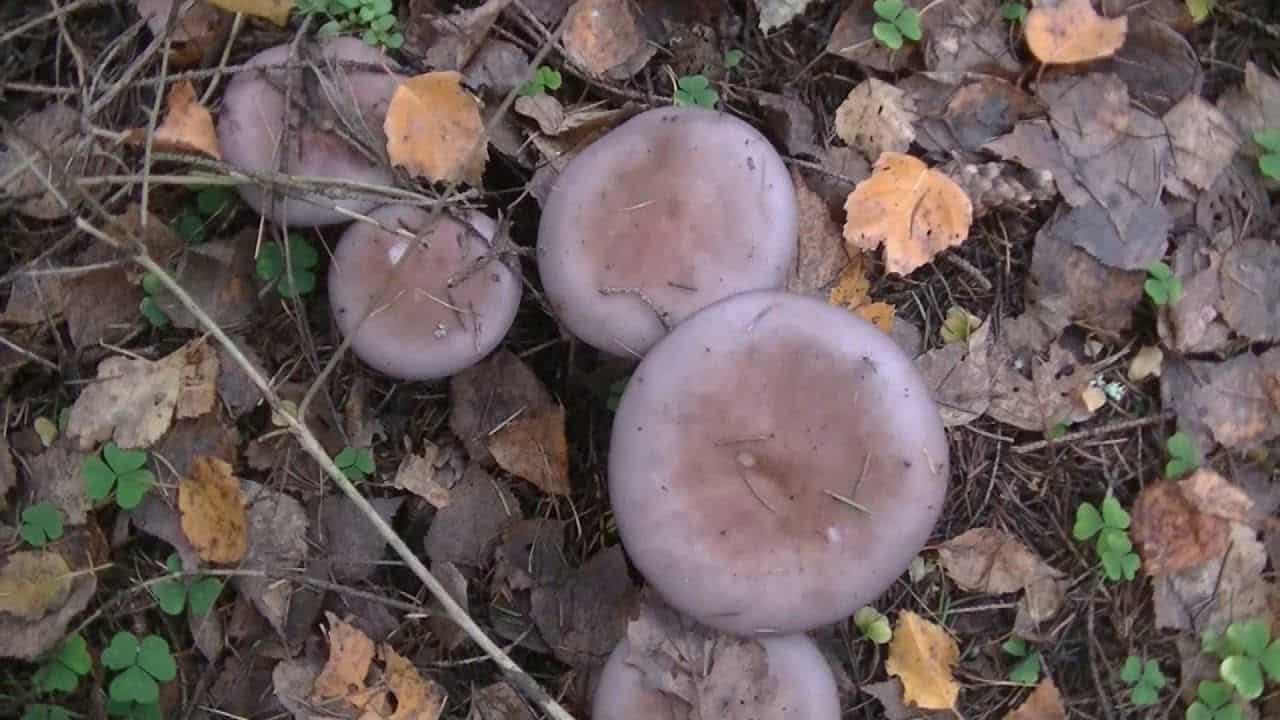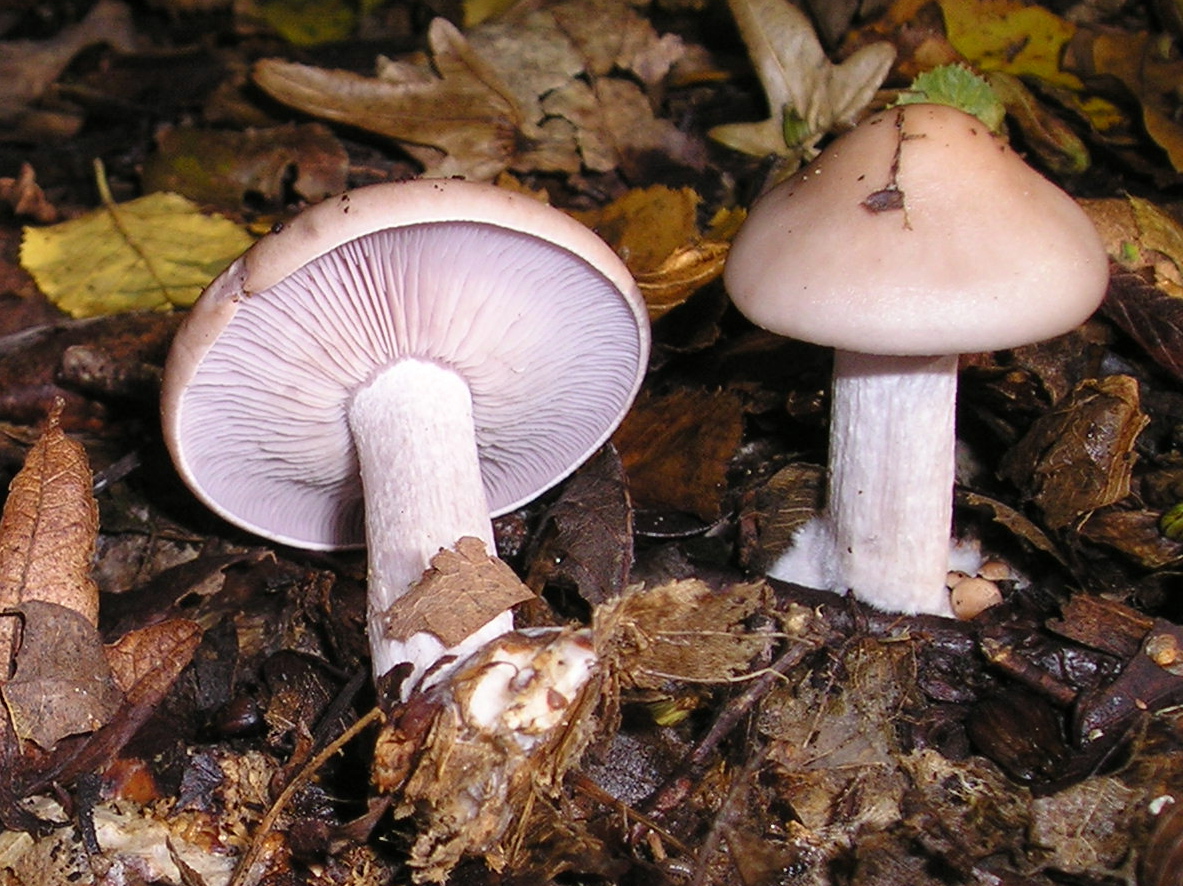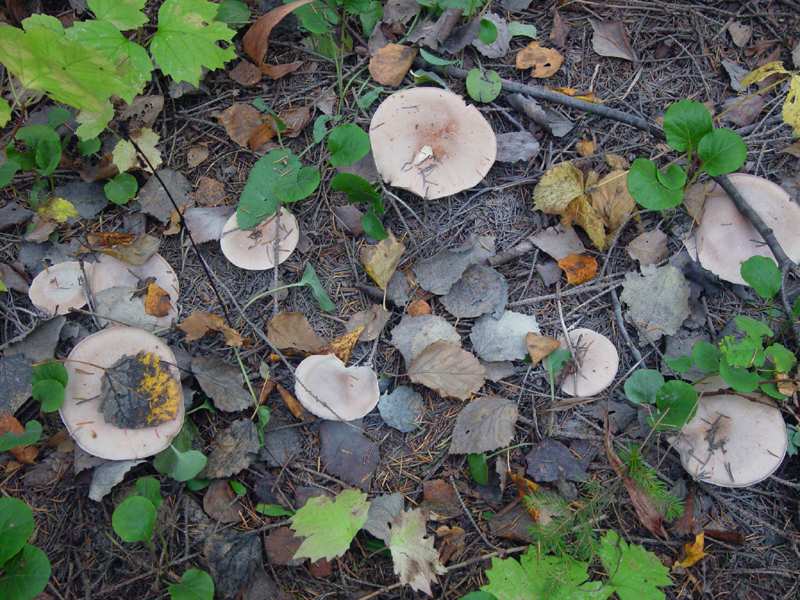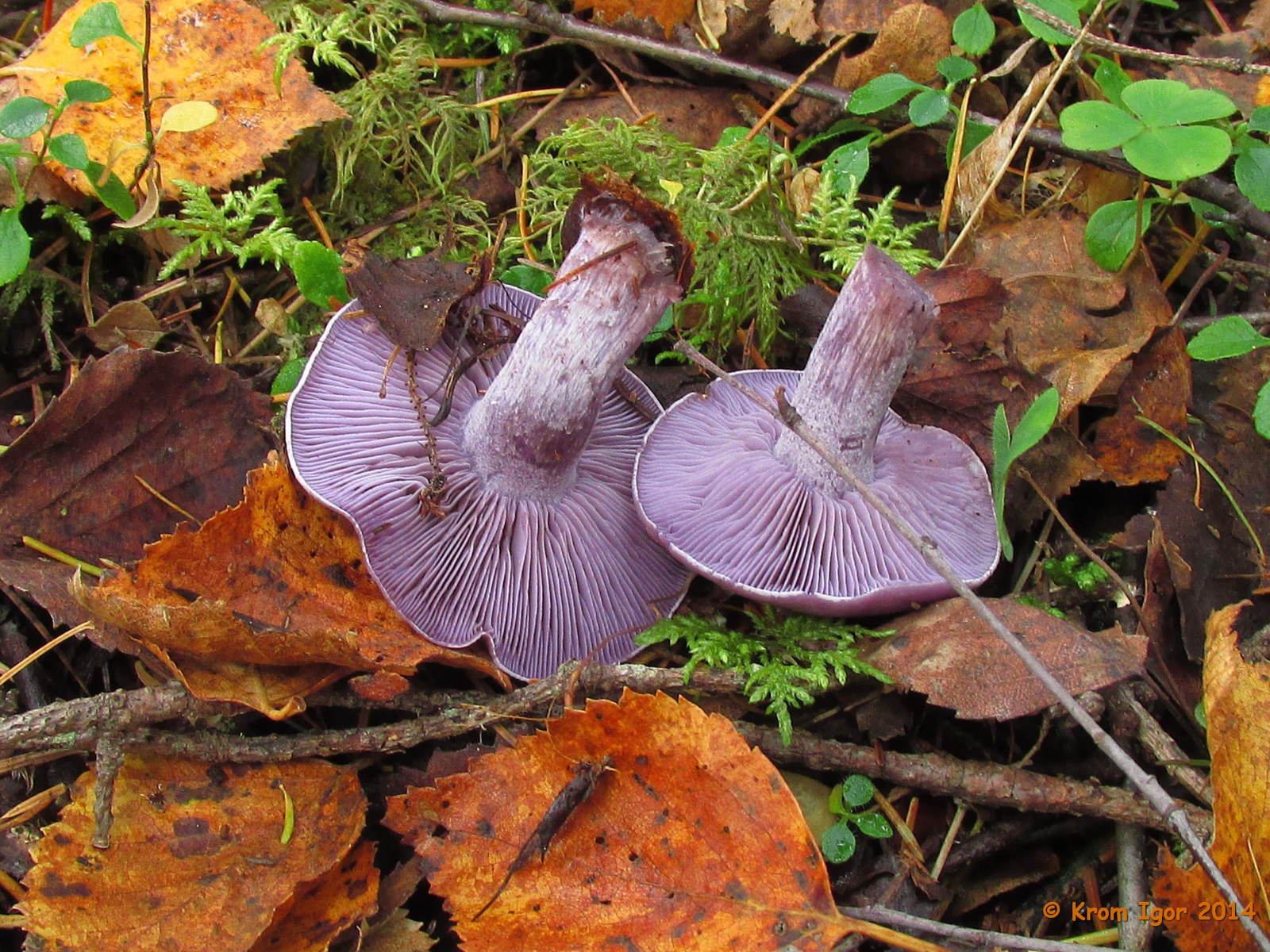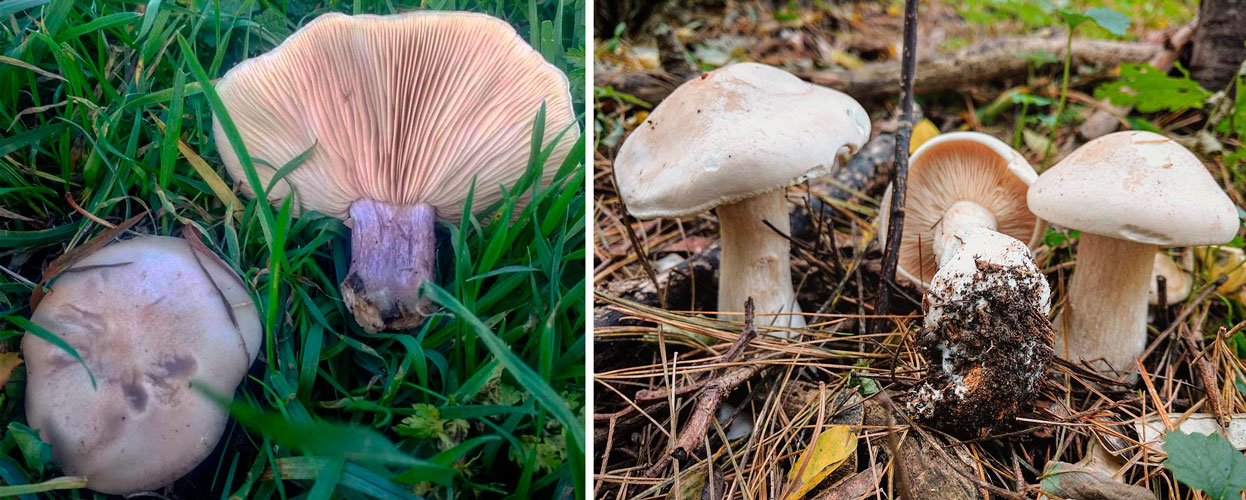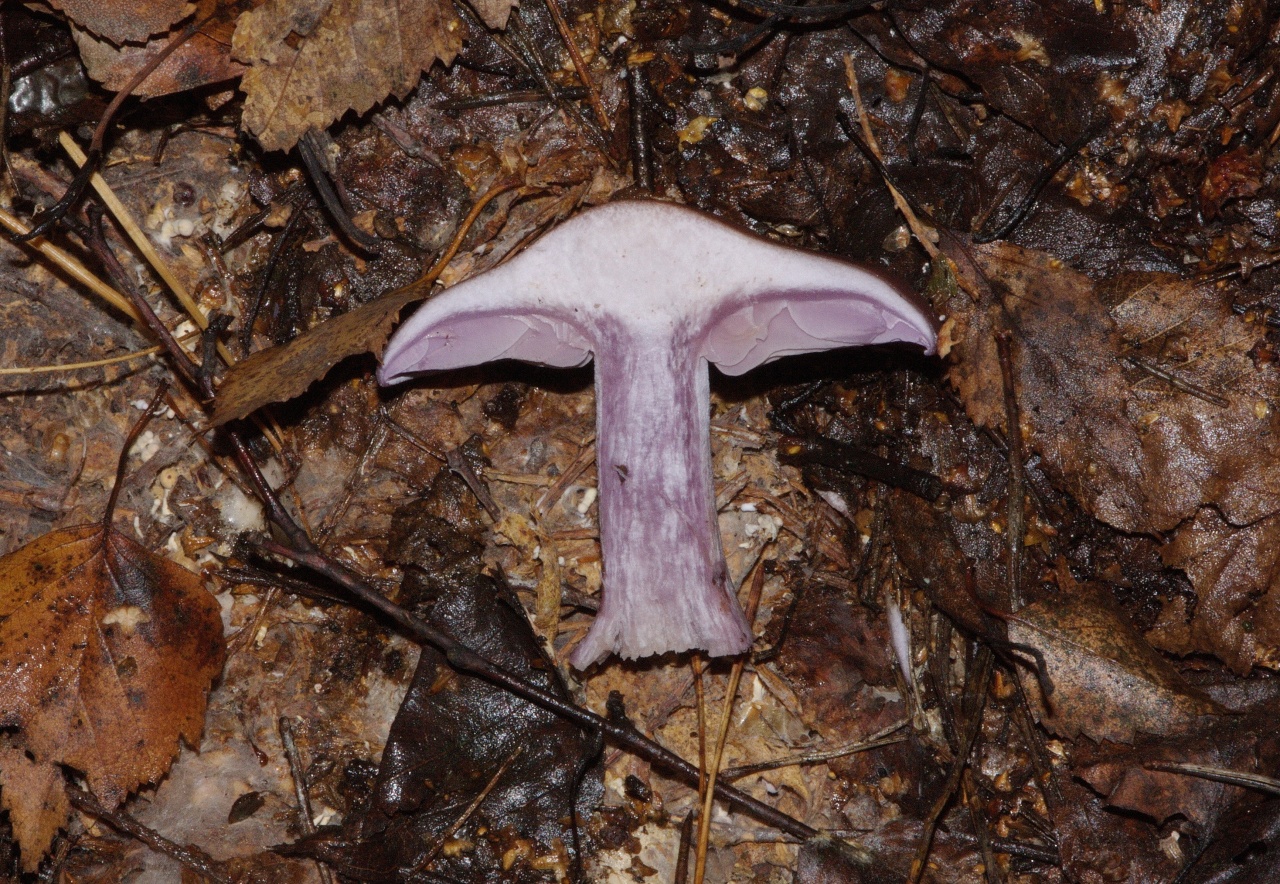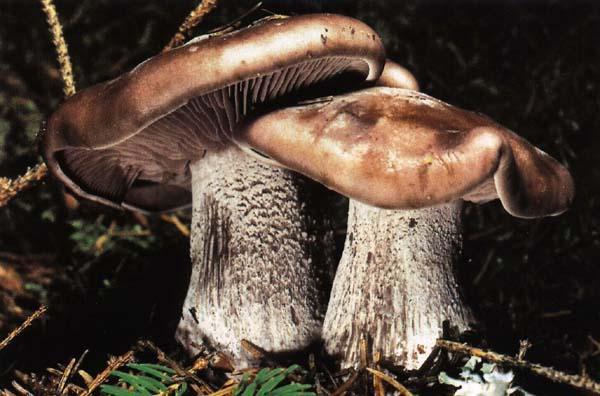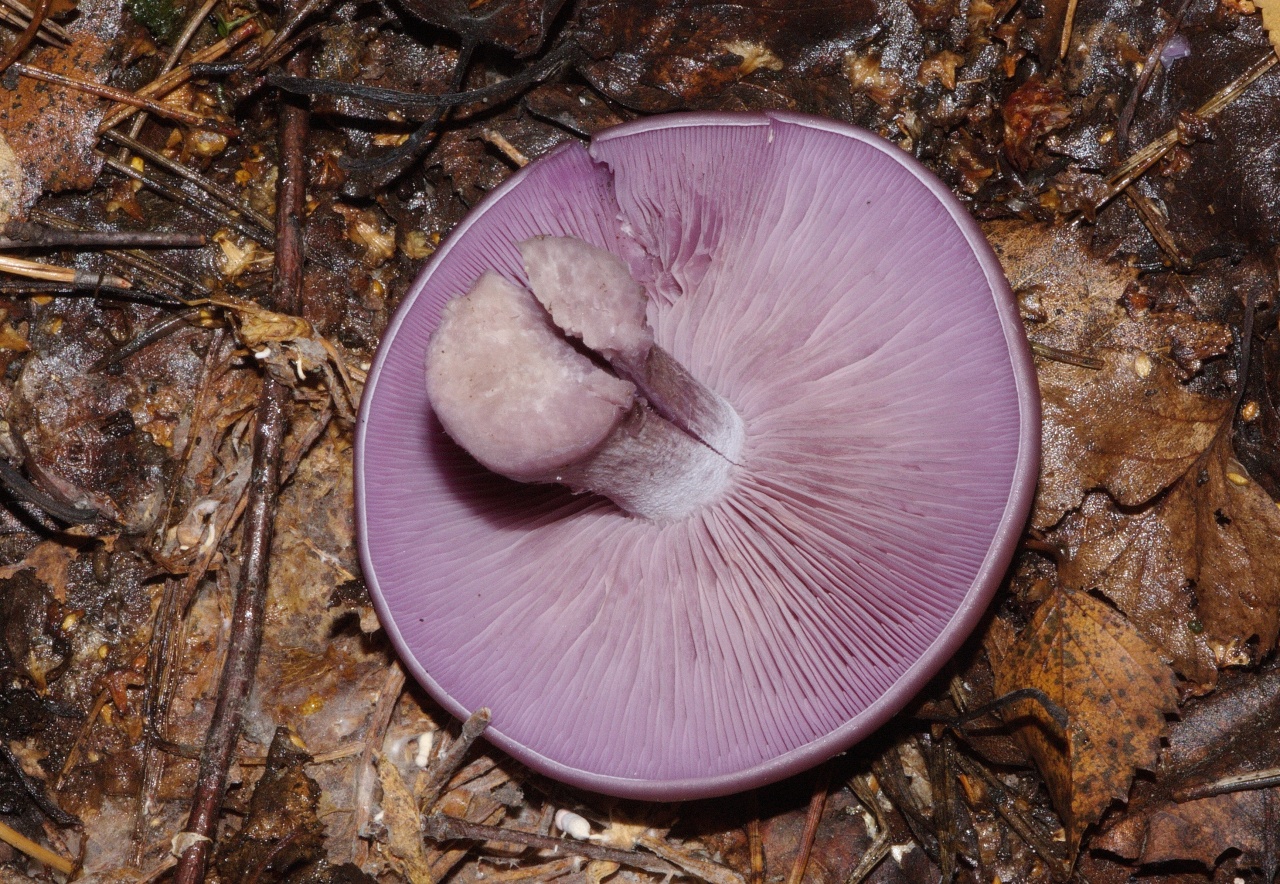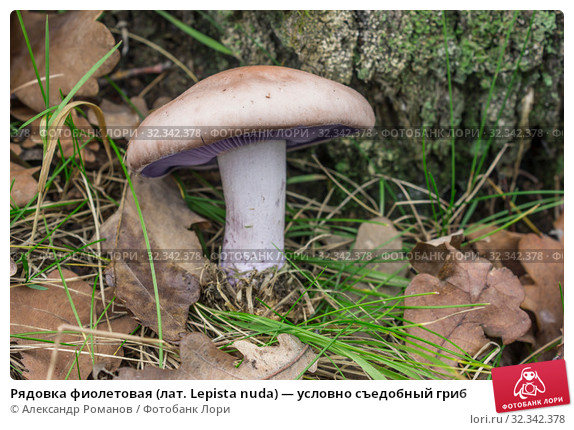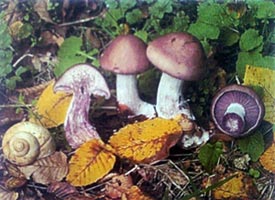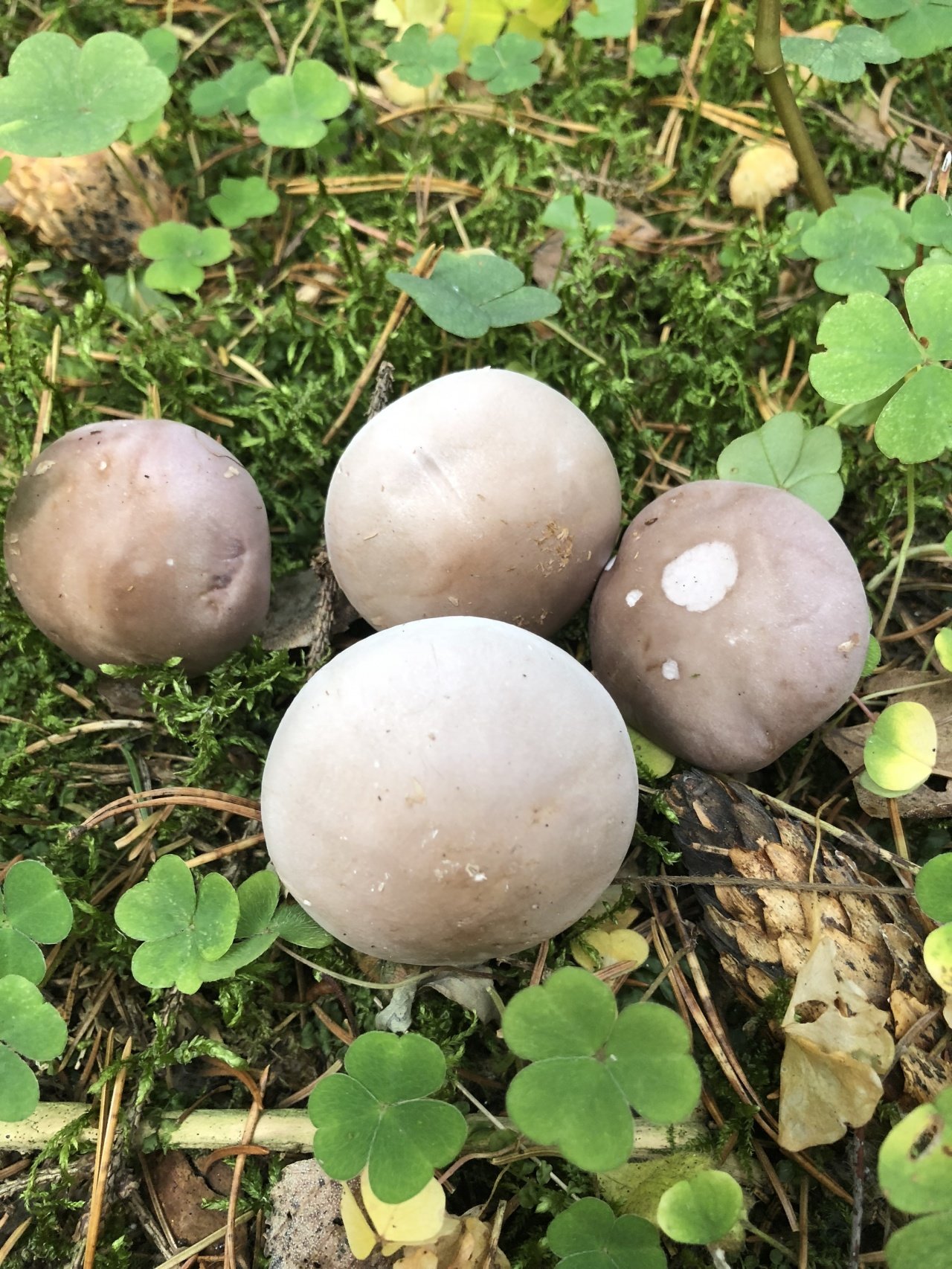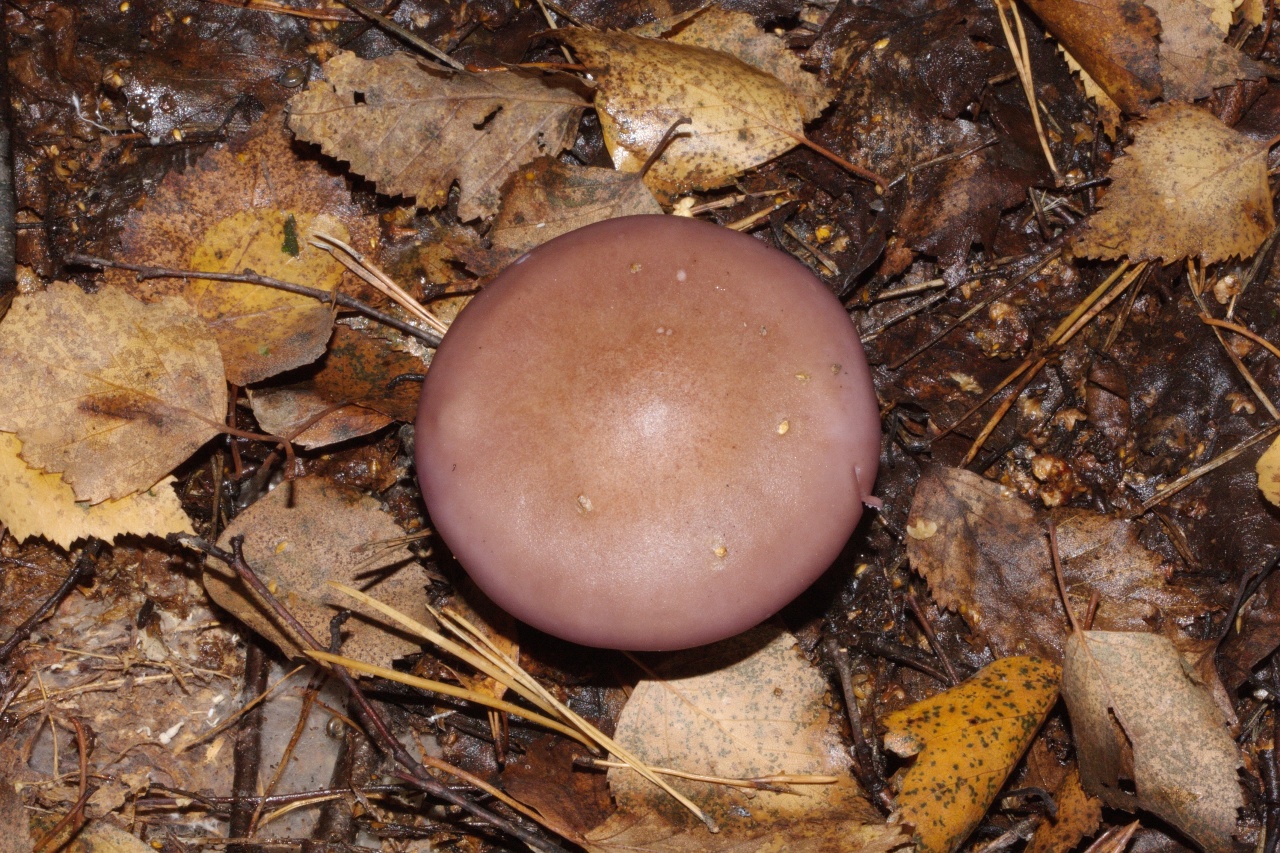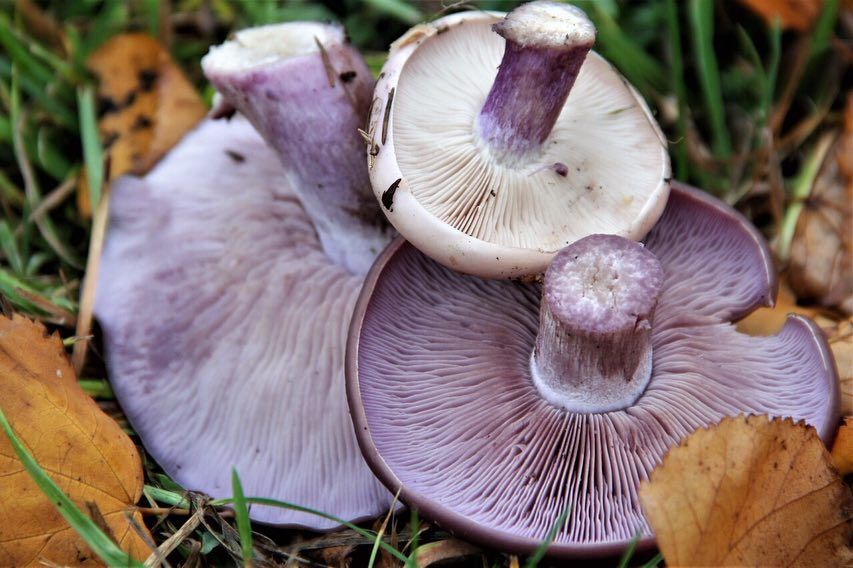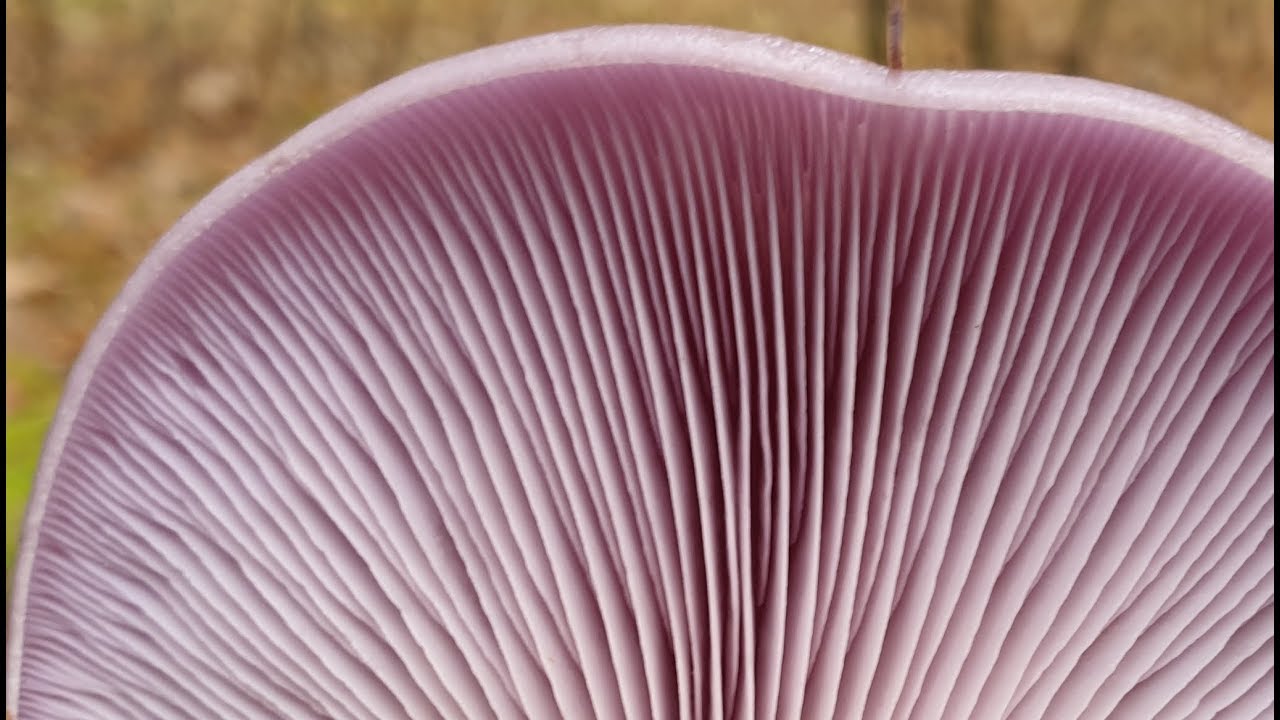Taste qualities of purple ryadovka
Row purple - conditionally edible mushroom. This mushroom has a pleasant aniseed scent. Before use, the purple ryadovka must be subjected to technical processing, that is, boiled. During cooking, the unpleasant smell and taste that are inherent in mushrooms growing on rotting surfaces disappear. It should be borne in mind that raw purple ryadovki can provoke an upset of the gastrointestinal system.
Similar species
The purple row can be confused with both edible and inedible mushrooms. This mushroom has similarities with such edible mushrooms as the violet row, the lilac ryadovka, the lilac laconic and the purple cobweb.

But the purple-footed row grows in open areas, the violet row has white flesh with a pinkish tinge, the purple cobweb is distinguished by the presence of a cobweb cover under the cap and a brown spore powder at a young age, the purple lacquer is characterized by a small size, fibrous stem and white spore powder.
Among the inedible similar species, one can distinguish a white-purple cobweb, a goat cobweb and a pure mycena. You can recognize the white-purple cobweb by the remains of the bedspread on the leg, which most often have a rusty brown color. The goat webcap has a bitter yellow flesh that smells unpleasant. It is possible to distinguish pure mycena thanks to the streaky cap and spore powder of white color.

Row lilac (Lepista saeva)
- Other names for the mushroom:
- Rowing lilac
- Rowing two-color
- Bluefoot
Other names:
- The teacher;
- Blue root;
- Lepista personata.
Lilac-footed ryadovka (Lepista saeva, Lepista personata) is a mushroom from the Ryadovok genus, belonging to the Ryadovkov (Tricholomov) family. This type of mushroom is very resistant to cold weather, and its growing season can continue even when the outside temperature drops to -4ºC or -6 ºC.
External description
The cap at the lilac-footed row has a diameter of 6-15 cm, in shape it is pillow-shaped, flat-convex. True, there are also such blue feet, in which the caps are simply huge, and reach 20-25 cm in diameter. The surface of the mushroom cap is smooth to the touch, and in color it is yellowish with a purple tint. The flesh of the cap in this type of mushroom is dense, thick, and in mature mushrooms it turns into loose. Its color is gray-violet, sometimes - gray, gray-brown, white. The pulp often emits a fruity aroma, has a pleasant sweetish aftertaste.
The fungal hymenophore is represented by the lamellar type. The plates in its composition are located freely and often, are characterized by a large width, yellowish or creamy color.
The leg of the lilac ryadovka is even, slightly thickened near the base. In length, it reaches 5-10 cm, and in thickness is 2-3 cm. In young bruises, the surface of the leg is covered with flakes (remnants of the bedspread), its fibrous structure is noticeable. As it matures, its surface becomes smooth. The color of the leg is the same as that of the cap of the described mushrooms - grayish-purple, but sometimes it can be bluish. Actually, it is the shade of the leg that is the main distinguishing feature of the purple-legged row.
Season and habitat of the mushroom
The lilac-footed row (Lepista saeva, Lepista personata) belongs to the category of southern mushrooms. Sometimes it is found in the Moscow region, the Ryazan region. In general, it is distributed throughout the territory of Russia. Active fruiting of the bluefoot occurs in the period from mid-spring (April) to mid-autumn (October). The described species of mushrooms chooses meadows, forests and pastures for its growth. A characteristic feature of lilac-footed rows is the principle of their arrangement.These mushrooms grow in colonies in large circles or rows. Bluefoots also love humus soils, so they can often be found near farms, in old compost pits and near residential buildings. This type of mushroom prefers to grow in open areas, but sometimes purple-footed rowers are also found in the forest. Often such mushrooms are found near deciduous trees (mainly scumpia or ash).
Edibility
The nutritional properties of the lilac ryadovka are good, this mushroom has a pleasant aftertaste and is similar in taste to champignons. Bluefoot is suitable for eating, very good in pickled and boiled form.
Similar types and differences from them
The relatively short purple leg will not give you the opportunity to confuse the bluefoot with any other mushroom, even if you are an inexperienced lover of "quiet hunting". In addition, lilac-footed rows are cold-resistant and are found in late autumn or even early winter. Other types of mushrooms do not have this feature.
Video about the mushroom Ryadovka purple-footed:
Recipes and cooking features
The most savory and beloved by many food is fried potatoes with onions and mushrooms. It is best to fry them in vegetable oil, but you can also use lard. It is better to boil the blue feet for a little earlier and let the water drain. Cut potatoes into slices, onion rings, cut large mushrooms into two or four parts. In some places there should be half as many of them as potatoes. 5 minutes before cooking, add spices and herbs to taste: dill, pepper and bay leaf.
Pickled bluefoot is very savory. This mushroom is pickled without legs. After you have cleaned and washed the hats, boil them for about 15 minutes, and drain the water. Pour the marinade over the caps and cook for another 20 minutes. For the marinade, you need to take two tablespoons of salt and sugar per liter of water, several leaves of laurel, currants and cherries, 10 peas of dark pepper and 5 cloves of garlic. 5 minutes before the end of cooking, add a spoonful of vinegar - and the savory mushrooms are ready.
Lepists cook in different ways. They can be fried, dried, boiled, pickled and salted. They are also used for preparing various appetizers and side dishes. Before cooking, mushrooms must be processed in a certain way.
Treatment
The procedure for processing a lepist includes the following steps:
- Sorting. Fruits are not combined with other types, so they need to be cooked separately.
- Scraping cleaning. A lot of debris often accumulates on the surface and in the plates, which is easier to remove before rinsing.
- Soaking. Compliance with this stage is imperative. Lepists are soaked in salt water for several hours. The water should be changed at least once.
- Washing. At this stage, the mushrooms are thoroughly washed under running water. It is advisable to use a brush.
- Boiling.Before use, the lepists must be boiled for 20-45 minutes.
Failure to follow any of the mushroom handling points can lead to indigestion or food poisoning.
Recipe options
Lepista in batter is a divine dish that everyone should try. For cooking, you need the following ingredients:
- mushrooms - 0.5 kg.;
- chicken egg - 3 pcs.;
- flour - 1.5 tbsp. l .;
- bread crumbs - 1.5 tablespoons;
- salt and pepper to taste;
- sunflower oil for frying.
 Rows in batter
Rows in batter
Another undoubtedly royal dish is the stew of lepista. For cooking, you will need the following products:
- rowers - 0.5 kg.;
- onions - 2-3 pcs.;
- carrots - 2 pcs.;
- sour cream - 200 g;
- salt and pepper to taste;
- sunflower oil for frying.
 Mushrooms in sour cream
Mushrooms in sour cream
Onions and carrots are sautéed until golden brown. Prepared rows are laid out in a saucepan and everything is poured with sour cream, adding spices. You need to cook the dish on low heat for 10 minutes. Stucco is served as a side dish. The dish is eaten hot.
Edible or not, the row is purple
Row usually grows in groups in mild climates in the northern hemisphere. They can be found in groves with various trees.But most of all they predominate in fir, hornbeam, pine and spruce forests. The basis for growth is coniferous and deciduous humus. Most often they can be found in open parts of the forest. Less commonly in pine and spruce forests, in a ditch, on the roadside near the forest, on a plot of land next to heaps of brushwood or straw.
The mushroom has a dense cap. Initially, it is completely purple in color, then it becomes dull purple mixed with brown. Its diameter is from 6 to 20 cm. The shape can be flat or slightly convex with uneven edges. The plates are often arranged, wide and thin. Their color also changes from purple to dull lilac. Ryadovka has a pinkish spore powder.
The leg has the shape of a cylinder, and becomes thicker towards the base. In all representatives of this species, it is even, fibrous and smooth. Its height ranges from 4 to 10 cm, and its thickness is from 1.2 to 3 cm. The flesh is light purple, dense and fleshy.
Despite its specific appearance, the purple row is easy to confuse with other mushrooms. Doubles can be recognized by the following criteria described in the table.
| Species name | Features | Category |
|---|---|---|
| Lilac Leopard (Bluefoot) |
|
Conditionally edible |
| Lepista Violet |
|
|
| Lakovica Lilac |
|
|
| Webcap Purple |
|
|
| Webcap White-purple |
|
Inedible |
| Goat webcap |
|
|
| Mycena Pure |
|
The purple edible fruit has a specific quality that helps with recognition. If the pulp is cut, it will take on a purple hue at the site of damage.
Description and photos of purple row mushrooms:
Row purple (Lepista nuda)
Synonyms: naked lepist, titmouse, cyanosis.
It is noteworthy that about a month before the beginning of fruiting, the purple ryadovka mycelium emerges on the surface of the forest litter. So to speak, it carries out reconnaissance in force. At first, the mycelium is almost white, pale bluish, but rather quickly turns into a light purple color characteristic of the fungus itself. Having found such a purple "cotton wool" enveloped in rotten needles and leaves, you can confidently take a note of the cherished place and come here in season for a guaranteed harvest.
The blues owe their pleasant fruity sweetish taste to the sugar trehalose, which is also found in meadow mushrooms. Cultivated in a number of countries.
Description of the purple row:
One of the most popular and most delicious late autumn rows. The cap is 4-20 cm in diameter, flat-convex, with a thin curved edge, naked, smooth, watery, moist, thick-fleshed. The color of the cap is necessarily with a significant proportion of violet: bright, dark or purple-violet, sometimes with an admixture of brown, in the center - brown-violet. Plates are frequent, purple, later light purple to pale lilac.
The pulp is thick, dense, bright purple, with age it fades like a cap or even stronger, the taste and smell are pleasant.Stem 3-10 x 0.7-3 cm, dense, cylindrical, slightly thickened below, covered with purple-brown felt mycelium at the base, purple at an early age, later lightening, whitish-mealy under the cap, sometimes hollow with age.
It is found throughout the temperate forest zone of Russia, in forests on soil and forest litter. Autumn mushroom, bears fruit in large groups from early September to late November (with peaks after the first cold in September and early October), often everywhere.
Healing properties of purple ryadovka:
The mushroom is high in vitamin B, stearic acid and ergosterol.
The extract of the cultural mycelium of this talker has anticancer properties and inhibits the growth of sarcoma-180 by 90% in laboratory animals, and Ehrlich's carcinoma by 100%. It has a strong cytotoxic effect on human cells of the L-1210 tumor line; in culture, it can inhibit the development of MCF-7 breast cancer and Walker 256 sarcoma.
The antibacterial action targets both gram-positive and gram-negative bacteria. The growth of E. coli, Staphylococcus aureus, Streptococcus pyogenes and Streptococcus enteretidis is inhibited. Antifungal activity was also found (suppresses Candida albicans).
Contains vitamin B, effective against beriberi disease, lowers blood glucose levels. Currently, on the basis of purple ryadovka, a dietary drug is being developed to control hypoglycemia.
In addition, ryadovka violet has anti-inflammatory and immunomodulatory activity, promotes platelet aggregation and increases the body's resistance to the influenza virus.
In Chinese medicine, regular consumption of food is believed to help maintain the nervous system. It is also used to regulate sugar metabolism, treat spleen, rheumatism and dermatophytosis of the legs.
It is not assembled for medicinal purposes in Russia.
Cooking Uses:
Edible and tasty mushroom, does not require (from our point of view) preliminary boiling. It is used for preparing first and second courses, snacks, salads, fillings.
Information about the allergenicity or toxicity of the violet row, which appeared at different times from different authors, has now been refuted by a number of studies. However, you should be aware that bruises are one of the most active bioaccumulators of anthropogenic pollution (ranked third after May mushroom and pigs), primarily heavy metals (tin, copper, mercury, cadmium). Therefore, you should avoid collecting them in city parks and in forests near industrial sites.
Mushroom ryadovka purple: photo and description
Family: Ordinary (Tricholomataceae).
Synonyms: naked lepist, titmouse, cyanosis.
Description. One of the most popular and most delicious late autumn rows.
Photo and description of the purple ryadovka gatherings with other types of these mushrooms, however, have some differences.
Pay attention to the photo of the purple row: the hat is 4-20 cm in diameter, flat-convex, with a thin curved edge. In a healthy fungus, it is naked, smooth, watery, moist, thick-fleshy
The color of the cap is necessarily with a significant proportion of violet: bright, dark or purple-violet, sometimes with an admixture of brown, in the center - brown-violet. The plates are frequent, purple, later light purple to pale lilac. The pulp is thick, dense, bright purple, with age it fades like a cap or even stronger, the taste and smell are pleasant. Leg 3-10 X 0.7-3 cm, dense, cylindrical, slightly thickened below.
In the photo of the mushroom, the purple ryadovka clearly shows that at the base the leg is covered with a purple-brown felt mycelium. At an early age, it is purple, later brightening, whitish-mealy under the cap, sometimes hollow with age.
Similar species.It differs from blue- and violet-colored cobwebs, first of all, by the absence of a clavate expansion at the base of the leg and a cobweb private veil that protects the plates at the cobwebs.
Medicinal properties: The mushroom is high in vitamin B1, stearic acid and ergosterol.
The extract of the cultural mycelium of this talker has anticancer properties and inhibits the growth of sarcoma-180 in laboratory animals by 90%, Ehrlich's carcinoma by 100%. It has a strong cytotoxic effect on human cells of the L-1210 tumor line; in culture, it can inhibit the development of MCF-7 breast cancer and Walker 256 sarcoma.
Antibacterial action is directed to both gram-positive and gram-negative bacteria. The growth of E. coli, Staphylococcus aureus, Streptococcus pyogenes and Streptococcus enteretidis is inhibited. Antifungal activity was also found (suppresses Candida albicans).
Contains vitamin B1, which is effective against beriberi disease, and lowers blood glucose levels. Currently, on the basis of purple ryadovka, a dietary drug is being developed to control hypoglycemia.
In addition, ryadovka violet has anti-inflammatory and immunomodulatory activity, promotes platelet aggregation and increases the body's resistance to the influenza virus.
Traditional Medicine Uses: In Chinese medicine, regular consumption of food is believed to help maintain the nervous system. It is also used to regulate sugar metabolism, treat spleen, rheumatism and dermatophytosis of the legs.
Cooking Applications: Like all edible rows, the mushroom does not require (from my point of view) pre-boiling. Used for preparing first and second courses, snacks, salads, fillings.
Information about the allergenicity or toxicity of the violet row, which appeared at different times from different authors, has now been refuted by a number of studies. However, you should be aware that bruises are one of the most active bioaccumulators of anthropogenic pollution (ranked third after May mushroom and pigs), primarily heavy metals (tin, copper, mercury, cadmium). Therefore, you should avoid collecting them in city parks and in forests near industrial sites.
Interesting Facts. It is noteworthy that about a month before the beginning of fruiting, the purple ryadovka mycelium emerges on the surface of the forest litter. At first, the mycelium is almost white, pale bluish, but rather quickly turns into a light purple color characteristic of the fungus itself. Having found such a purple "cotton wool" enveloped in rotten needles and leaves, you can confidently take a note of the cherished place and come here in season for a guaranteed harvest.
The blues owe their pleasant fruity sweetish taste to the sugar trehalose, which is also found in meadow mushrooms.
Cultivated in a number of countries.
Recipes and cooking features
The purple rower is a conditionally edible mushroom. This species has its own individual characteristics, which can be found by looking at the photo and reading the detailed description of the mushroom. The distinctive features of the ryadovka are quite bright and make it possible to differentiate the mushroom in the forest almost unmistakably.
Appearance and photos
Rows of this type have a very striking appearance:
- purple or purple hat;
- the same color of the plate;
- light purple leg.
Lepista grows to medium size. The diameter of the cap varies from 6 to 15 cm, the legs - from 1.5 to 2.5 cm.The height of the mushroom reaches 8 cm.

Distinctive features of the mushroom:
-
The cap is flat, slightly convex, with irregular edges. The texture is dense, fleshy. Young fruits have a rich purple color. The cap of aging mushrooms becomes lavender with a brown tint.
-
The leg is even, smooth, has a fibrous structure. The shape is cylindrical, thickened at the base. In young rows, it is solid, but as they grow older, cavities appear in the leg.There is a light coating in the form of flakes under the cap. At the base of the peduncle, a violet edge is visualized.
- The plates are initially purple in color, but over time they acquire a lilac-gray color. They are presented in a large number, have different sizes and hold freely.
- The pulp is fleshy, dense, elastic. It gets softer as it gets older. In young individuals, it has a greyish-purple color, in older individuals it is cream. When damaged, the pulp emits a persistent smell of anise.
Officially, the ryadovka belongs to the conditionally edible category. This means that you can eat it only after a certain processing, observing all the rules of preparation, namely, after 20 minutes of boiling in salt water. This will not only prevent disturbances in the digestive tract, but also get rid of the specific putrid smell and taste of the mushroom.
Lepists grow in large groups, creating densely populated meadows. You can definitely find smoky talkers next to them. The first copies appear in early September. You can pick mushrooms until frost.
Collect away from highways and industrial facilities. In such places, the rows become toxic due to the property of absorbing production waste. It is advisable to go to the training camp early in the morning - at this time of the day the mushrooms are better visible.
 General information about the mushroom
General information about the mushroom
Separate the mushroom units from the mushroom place using a sharpened tool. In no case should you break the rows. Damaged myceliums can no longer bear fruit and die.
Lepists cook in different ways. They can be fried, dried, boiled, pickled and salted. They are also used for preparing various appetizers and side dishes. Before cooking, mushrooms must be processed in a certain way.
Treatment
The procedure for processing a lepist includes the following steps:
- Sorting. Fruits are not combined with other types, so they need to be cooked separately.
- Scraping cleaning. A lot of debris often accumulates on the surface and in the plates, which is easier to remove before rinsing.
- Soaking. Compliance with this stage is imperative. Lepists are soaked in salt water for several hours. The water should be changed at least once.
- Washing. At this stage, the mushrooms are thoroughly washed under running water. It is advisable to use a brush.
- Boiling.Before use, the lepists must be boiled for 20-45 minutes.
Recipe options
Lepista in batter is a divine dish that everyone should try. For cooking, you need the following ingredients:
- mushrooms - 0.5 kg.;
- chicken egg - 3 pcs.;
- flour - 1.5 tbsp. l .;
- bread crumbs - 1.5 tablespoons;
- salt and pepper to taste;
- sunflower oil for frying.
 Rows in batter
Rows in batter
First, the batter is prepared: beat 3 eggs with a whisk until smooth and add flour, salt and pepper there. Prepared lepists are dipped one by one in batter, and then rolled in bread crumbs. Mushrooms are spread in a hot frying pan with oil and fried on both sides. The dish can be served both cold and hot. It is eaten as a snack or as a main course.
Another undoubtedly royal dish is the stew of lepista. For cooking, you will need the following products:
- rowers - 0.5 kg.;
- onions - 2-3 pcs.;
- carrots - 2 pcs.;
- sour cream - 200 g;
- salt and pepper to taste;
- sunflower oil for frying.
 Mushrooms in sour cream
Mushrooms in sour cream
Onions and carrots are sautéed until golden brown. Prepared rows are laid out in a saucepan and everything is poured with sour cream, adding spices. You need to cook the dish on low heat for 10 minutes. Stucco is served as a side dish. The dish is eaten hot.
Two-color row (Lepista saeva)
- Other names for the mushroom:
- Lilac-footed row
- Rowing lilac
- Bluefoot
Other names:
- The teacher;
- Blue root;
- Lepista personata.
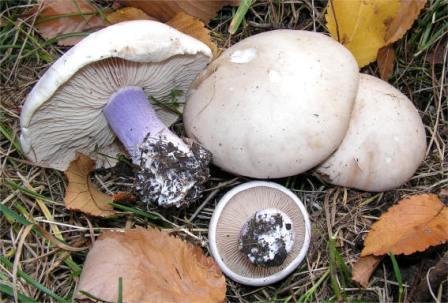
Two-color row (Lepista saeva, Lepista personata) is a mushroom from the Ryadovok genus, belonging to the Ryadovkov (Tricholomov) family.This type of mushroom is very resistant to cold weather, and its growing season can continue even when the outside temperature drops to -4ºC or -6 ºC.
External description
The cap at the lilac-footed row has a diameter of 6-15 cm, in shape it is pillow-shaped, flat-convex. True, there are also such blue feet, in which the caps are simply huge, and reach 20-25 cm in diameter. The surface of the mushroom cap is smooth to the touch, and in color it is yellowish with a purple tint. The flesh of the cap in this type of mushroom is dense, thick, and in mature mushrooms it turns into loose. Its color is gray-violet, sometimes - gray, gray-brown, white. The pulp often emits a fruity aroma, has a pleasant sweetish aftertaste.
The fungal hymenophore is represented by the lamellar type. The plates in its composition are located freely and often, are characterized by a large width, yellowish or creamy color.
The leg of the lilac ryadovka is even, slightly thickened near the base. In length, it reaches 5-10 cm, and in thickness is 2-3 cm. In young bruises, the surface of the leg is covered with flakes (remnants of the bedspread), its fibrous structure is noticeable. As it matures, its surface becomes smooth. The color of the leg is the same as that of the cap of the described mushrooms - grayish-purple, but sometimes it can be bluish. Actually, it is the shade of the leg that is the main distinguishing feature of the purple-legged row.
Season and habitat of the mushroom
The two-color row (Lepista saeva, Lepista personata) belongs to the category of southern mushrooms. Sometimes it is found in the Moscow region, the Ryazan region. In general, it is distributed throughout the territory of Russia. Active fruiting of the bluefoot occurs in the period from mid-spring (April) to mid-autumn (October). The described species of mushrooms chooses meadows, forests and pastures for its growth. A characteristic feature of lilac-footed rows is the principle of their arrangement. These mushrooms grow in colonies in large circles or rows. Bluefoots also love humus soils, so they can often be found near farms, in old compost pits and near residential buildings. This type of mushroom prefers to grow in open areas, but sometimes purple-footed rowers are also found in the forest. Often such mushrooms are found near deciduous trees (mainly scumpia or ash).

Edibility
The nutritional properties of the lilac ryadovka are good, this mushroom has a pleasant aftertaste and is similar in taste to champignons. Bluefoot is suitable for eating, very good in pickled and boiled form.
Similar types and differences from them
The relatively short purple leg will not give you the opportunity to confuse the bluefoot with any other mushroom, even if you are an inexperienced lover of "quiet hunting". In addition, lilac-footed rows are cold-resistant and are found in late autumn or even early winter. Other types of mushrooms do not have this feature.
Video about a mushroom Ryadovka two-color:
Evaluation of taste, benefits and possible harm
When preparing and harvesting titmouses, it is important to remember that, despite its visual appeal, it is still a conditionally edible mushroom that can be poisoned if prepared incorrectly. Row purple contains a large amount of vitamins B1 and B2, manganese, zinc and copper
It also contains ergosterol (provitamin D2) and stearic acid. Calorie content of cyanosis - 19 kcal / 100 g
The purple row contains a large amount of vitamins B1 and B2, manganese, zinc and copper. It also contains ergosterol (provitamin D2) and stearic acid. The calorie content of cyanosis is 19 kcal / 100 g.
The medicinal properties of Lepists naked are widely used in pharmaceuticals. Antibiotics, antifungal drugs are made from this type. The property of ryadovka violet is known to reduce glucose levels, which is actively used for the manufacture of drugs for the control of hyperglycemia. Titmouse supports immunity, has anti-inflammatory properties.
The harm of ryadovka lies in the possibility of confusing it with poisonous species. In addition, it is forbidden to eat mushrooms for children under 9 years old, pregnant and lactating women, people with diseases of the gastrointestinal tract.
Important! You cannot pick mushrooms near roads, highways, near large enterprises. Fruit bodies tend to absorb harmful microelements like sponges.
Mushroom ryadovka may: photo and description, how to identify edible mushroom, distribution sites
Rowing May is an edible mushroom that grows in spring during the season of collecting lines and morels. He chooses a variety of places for growing: illuminated areas of the forest, the sides of field and forest roads, thin grass at the edges of fields, meadows and gardens. It can be found even in urban environments such as flower beds or lawns.
How to determine the May ryadovka, because this mushroom does not grow along with the usual types of ryadovka in the autumn? It is worth noting that the fruit body has a rather modest appearance, because its cap, stem and plates are of the same color - whitish or cream. Sometimes novice mushroom pickers confuse the May row with champignons. According to them, the taste of this mushroom is not inferior to even the best autumn species.
Mushroom May ryadovka: photo and description
The description of the May ridge resembles a poisonous white ryadovka, which is very toxic. This is probably why the May mushroom is not as popular as others. And not every lover of "quiet hunting" is ready to wander through the forest in the spring in search of this species. But there are gourmets who happily assemble this particular row and fill their baskets to overflowing with it.
It is known that the poisonous white row has the same color as the May one. However, it begins to bear fruit at the end of August and continues until the first frost. The smell of this mushroom is very unpleasant and pungent, reminiscent of the smell of mold. Compare the photo showing the mushroom ryadovka May and the ryadovka white in natural conditions.
Since May mushrooms belong to ryadovki, they also grow in groups, forming "witch's rings". The fruit body smells like fresh flour, although some mushroom pickers claim that it has a cucumber aroma or resembles the smell of mowed grass.
We invite readers to familiarize themselves with the description and photo of the May ryadovka, which will help to correctly identify this edible type of mushroom.
Latin name: Calocybe gambosa.
Family: Lyophilic.
Synonyms: T-shirt, May mushroom, Georgiev mushroom, Calocybe May.
Hat: at a young age it has a flat-convex or hump-shaped shape, the size varies from 3 to 10 cm.Over time, it becomes semi-spread and takes on a flaky-fibrous appearance.
The surface is dry to the touch, white or pale cream shade. Very old specimens of mushrooms acquire ocher color.
Pay attention to the photo of the edible mushroom of the May row, as well as the shape of the cap at different stages of development. Leg: cylindrical, narrowed or widened downwards
White or pale cream in color, slightly yellowish in adulthood
Leg: cylindrical, narrowed or widened downwards. White or pale cream in color, slightly yellowish in adulthood.
At the base, it usually has a rusty ocher tint. Height from 3 to 9 cm, width from 1.5 to 3.5 cm.
Flesh: dense, white, color does not change until old age. It tastes like fresh flour with a specific smell of cucumber or grass cuttings.
Plates: narrow, thin and frequent, white, which become creamy in adulthood.
Application and distribution of the May ryadovka
Application: not suitable for consumption raw. Great for winter preparations and other culinary treatments.
Edibility: belongs to the edible species of the 4th category, however, in terms of useful qualities, it is not inferior even to beef liver.
Similarities and differences: its fruiting season begins in May and lasts only about a month, so the mushroom has no similar twins.However, it is sometimes confused with the poisonous spring entomola, although its color is much darker than that of the ryadovka, and the stem is much thinner.
Distribution: in open areas, in small forests, in thickets of rare bushes, in meadows, pastures. Very often it can be found where morels or lines used to grow.
Grows in large groups or rows, choosing a low grassy litter. The May ryadovka mushroom is most often found on sandy soil in pine or birch-pine forests. Begins fruiting in early or mid-May and continues until late June.
It is found in the Far East, Siberia, the Urals, as well as throughout Europe.
Having a description and a photo of the mushroom ryadovka in May, each mushroom picker will be able to correctly identify this species and collect a large mushroom harvest. The taste and nutritional properties of the first spring mushrooms will delight you and your loved ones, as well as diversify your daily diet.
Description of the purple row
The diameter of the head of a row of purple can vary from 6 to 15 centimeters, and in large mushrooms, the diameter can be up to 20 centimeters. The shape of the cap is convex, the hemispherical edge is thin, rolled downwards. Over time, the shape of the cap changes to a convex-outstretched one or becomes depressed with curved edges, sometimes the edge is wavy-curved.
The cap is covered with a shiny, smooth skin. In youth, the color of this mushroom is bright purple, but over time it begins to fade from the edge, becomes ocher or brownish. In dry weather, the skin becomes lighter.

The pulp is dense, fleshy, light purple in color, over time it becomes soft, crimson-cream color. The pulp is fragrant and tasty, reminiscent of the smell of anise. The width of the plates is 0.6-1 centimeters, they are thin in shape, they are often located. The plates grow with teeth or are located almost freely. The color of the plates is purple, over time it fades and becomes brown.
The height of the leg is 4-8 centimeters, sometimes it can reach 10 centimeters, and its thickness ranges from 1.2 to 3 centimeters. The flesh of the leg is firm. The shape is cylindrical or sometimes clavate, there is a thickening at the base. The surface is smooth, longitudinally fibrous. There is a flaky bloom on the leg next to the cap. In young rows of purple, the structure of the leg is solid, but cavities form over time. The color is bright purple, as the fungus ages, it changes to gray-violet, then brightens and becomes brownish. At the base of the peduncle there is a pubescence of a violet hue.

The shape of the spores is ellipsoidal, the surface is slightly rough, the color is pinkish. Pale pink spore powder.
Places of growth of the purple row
Purple rows grow on the soil, next to heaps of straw or brushwood, in the litter, on the fallen needles. They are found in coniferous (spruce and pine forests) and forests mixed with spruce and oak. They can also grow in gardens, on compost heaps.
The purple row is a saprophytic mushroom that grows on fallen, rotten foliage. The harvesting season for the purple row is from August to December. The peak yield begins in the second half of September and lasts until the first frost in October. Mushrooms bear fruit singly or in groups, often found in the form of "witch circles". Sometimes they can be found next to smoky talkers.
Purple rows are able to withstand light frosts, so they grow in the temperate zone of the Northern Hemisphere. Also found in Australia.


